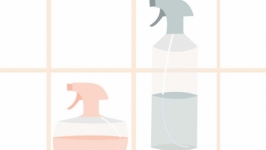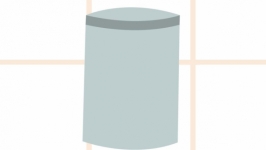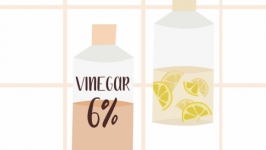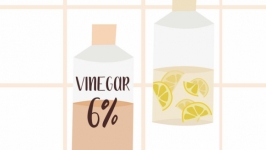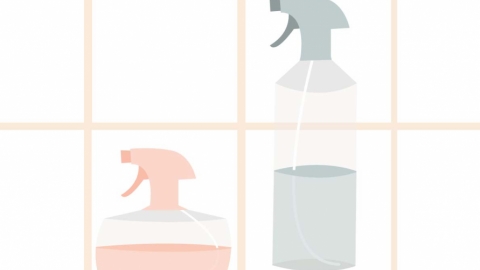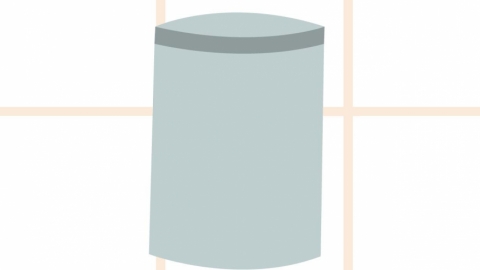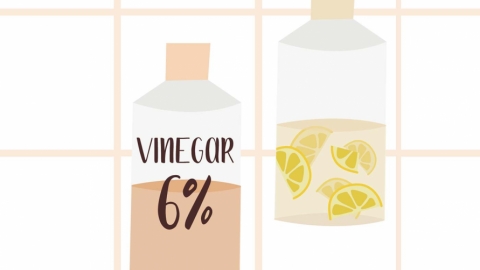The Dirt on Clean
 “The more I researched, the more I realized that all kinds of additives, some of them toxic chemicals, are in so many of the common products we use, as well as in the processed foods we eat daily.” –Carol Berry
“The more I researched, the more I realized that all kinds of additives, some of them toxic chemicals, are in so many of the common products we use, as well as in the processed foods we eat daily.” –Carol BerryCarol Berry is on a twofold mission: to educate people about the toxic chemicals in many common household cleaning and personal care products, and to provide simple, healthy, and effective alternatives that can be made at home. An art educator and writer, Carol lives in Manchester with her husband, Steve Berry, a Congregationalist pastor and former state legislator. I asked Carol in early winter to share some of her vast knowledge. Several hours later, we had barely scratched the surface.
What sparked your interest in this topic?
Carol Berry: While taking our New York City youth group down to West Virginia on a Habitat for Humanity mission trip in the 1980s, my husband Steve, our three sons, and I made a side trip to visit Chief Two Trees, a medicine man and chief of the Cherokee Nation at the time. He made an indelible impression on us. One of the things I remember him saying was that we must be responsible for ourselves and our lives and not abdicate all our difficult situations to others—doctors, lawyers, whomever. He did a little healing for one of our sons who had a persistent cough and told us which natural remedies we could make and use. That was the first time I realized I didn’t have to rely only on the doctor and get a pill or a drug, but that there were other alternatives and natural resources. This journey was a slow-rolling ball but has sped up significantly in the last few years since I’ve begun to research and speak out more on this subject.
How did your background shape your current beliefs?
CB: I grew up in Holland and moved to Switzerland when I was 8. I lived there until I immigrated to the United States in 1974. Looking back, our lifestyle was 20 years behind what America was doing, for example, in terms of the availability of processed foods and the fast-food movement. We prepared meals from fresh produce bought daily at our markets. I was amazed when I came to the United States and saw boxes of cake mix where all you had to do was add water and an egg…. We also had far fewer cleaning and body products to choose from. In the early years in America, I didn’t have a TV so I wasn’t exposed to many advertisements that were promoting the ever more potent cleaning products and time-saving precooked TV dinners.
We are what we eat, after all….
CB: …and what we put on our bodies. The vast array of body products I found in America amazed me, too. It took years before I started studying the ingredients of the products I was putting on my body and using in my home. Because our skin is our biggest organ that absorbs what we apply to it, I believe we shouldn’t put anything on our skin that we couldn’t put in our mouth. The more I researched, the more I realized that all kinds of additives, some of them toxic chemicals, are in so many of the common products we use, as well as in the processed foods we eat daily. I started to collect piles of information and to share the knowledge with friends. And I reverted back to the old ways of preparing foods and running a household.
“We need to put the brakes on and realize how we’ve been convinced to use products that were designed to make life ‘easier’ for us but aren’t necessarily good for us. ” –Carol Berry
How can companies get away with not listing all the chemicals and ingredients they use?
CB: Well, most of the ingredients are listed, but with confusing names and abbreviations. But the companies aren’t required to reveal certain ingredients that are part of their trade secrets. If you see the words “natural ingredients,” “fragrance,” or “perfume,” those can be phthalates and other chemicals added to make something smell or taste natural. “Fragrance” is often a word for something created in a lab to mimic the real thing. Once you catch on to these terms, you begin to question the health effects of these additives and to read the labels more carefully. If the label says “essential oil of lavender or lemon,” it most likely refers to the real essence.
Is it safe to assume all the chemicals used in cleaning products, for example, are toxic?
CB: I tend to think that a certain number are. And keep in mind, these chemicals are not needed. You can clean almost anything with just baking soda, water, and vinegar!
So how did we get to this point with all the unpronounceable ingredients in our everyday household products?
CB: It started in the early part of the 20th century when people began to embrace the concept of “better living through chemistry” promulgated by chemical companies. Advertising swayed us to believe that these products made life easier. We need to put the brakes on and realize how we’ve been convinced to use products that were designed to make life “easier” for us but aren’t necessarily good for us. We should be skeptical and do our homework.
You can clean almost anything with just baking soda, water, and vinegar!

Let’s talk about some safer DIY alternatives, and the essentials we should stock.
CB: To be clear, I do buy products; I don’t make everything from scratch. I have found national companies—Seventh Generation and Dr. Bronner’s—that make safe products using trustworthy ingredients.
But you can make all-purpose kitchen and bath cleaners, liquid laundry detergent, and disinfecting sprays from basic grocery-store items. Just keep a supply of white vinegar, lemon juice, salt, baking soda, washing soda (which is baking soda baked at 400˚F for an hour), castile liquid soap, hydrogen peroxide, and essential oils such as lavender, rosemary, lemon, peppermint, eucalyptus, and tea tree.
People will say to me, “I’m working full time; I don’t have time to read labels, I just need to pick up a bottle of laundry detergent. I don’t have time to make a batch of homemade cleaning products.” And I understand. But it’s like cooking—once you do it and carve out the time, it becomes part of your routine. And once you discover that some cleaning products use fewer ingredients without added artificial scents, for example, you can make decisions to buy those.
“You can make all-purpose kitchen and bath cleaners, liquid laundry detergent, and disinfecting sprays from basic grocery-store items.” –Carol Berry
Three reasons why people should make their own?
CB: To avoid unnecessary additives and toxic chemicals. To not pollute your body or the environment around you. And to save money!
I have a sense of satisfaction trying to understand what’s in the product and taking control of my home environment. It’s embracing the way things used to be, the way our grandparents cleaned and lived, before chemistry took over. A good way to clean and shine wood? Olive oil mixed with a little vinegar. Put that on a cleaning cloth and buff your floors or your tabletop. The vinegar cleans and the oil restores luster.
What’s your feeling about commercial air fresheners and scented candles?
CB: You’re adding toxic chemicals into the air you breathe, worse for you than the air you smelled before! Just add a few drops of lemon oil or a couple of sprigs of rosemary to a pot of gently boiling water on the stove. Rosemary has antimicrobial properties. That steam infused with lemon or rosemary will purify and refresh the air. This is simple. You don’t have to go to great lengths to create healthy air in your own home. Scented candles? Read the label carefully. Many are made with paraffin and have artificial scents added. Buy beeswax, which have their own beautiful aroma, or soy candles scented with essential oils.
We’ve become a hand sanitizer generation. And now studies show that we’re too clean and it’s backfiring!
CB:That’s right! Triclosan is an antibacterial chemical found in soaps, hand sanitizers, cosmetics, toothpastes, and antiperspirants. You absorb triclosan into your body, and it doesn’t make any distinction between the good and bad bacteria. That may contribute to antibiotic resistance in bacteria. Soap and water make hands perfectly clean, especially soap that contains essential oils of rosemary or lavender, which are naturally antimicrobial and antiseptic. Avoid products with triclosan or Microban.
People are coming to understand that simpler and fewer ingredients is usually better, healthier for themselves and for the environment. In a world where everything seems out of control, you can control what you eat, put on your body, and how you clean your home. And in the end, it will be cheaper, safer, and healthier. Thanks to Carol’s inspiration, Maria Reade now stocks up on Dr. Bronner’s and myriad essential oils.
TRUSTED RESOURCES FOR MAKING DECISIONS ABOUT CHEMICALS IN PRODUCTS
- The Environmental Working Group is an excellent resource. It has safety ratings for cleaning products and body products.
www.ewg.org- David Suzuki’s Living Green
www.davidsuzuki.org/living-green- No More Dirty Looks is a beautiful book especially for teenage girls and young women who are looking for healthy body care products to buy or make themselves.
LIVING GREEN CLEANING RECIPES
Rid your home of the chemicals and petroleum-based ingredients found in most cleaning products by making your own. Tested by the Living Green team, these homemade cleaners are versatile, affordable, and eco-friendly.
TIP: Label your finished products and store them safely away from children and pets.
Note: Washing soda, or sodium carbonate, is more caustic and has a higher pH than its cousin, baking soda.
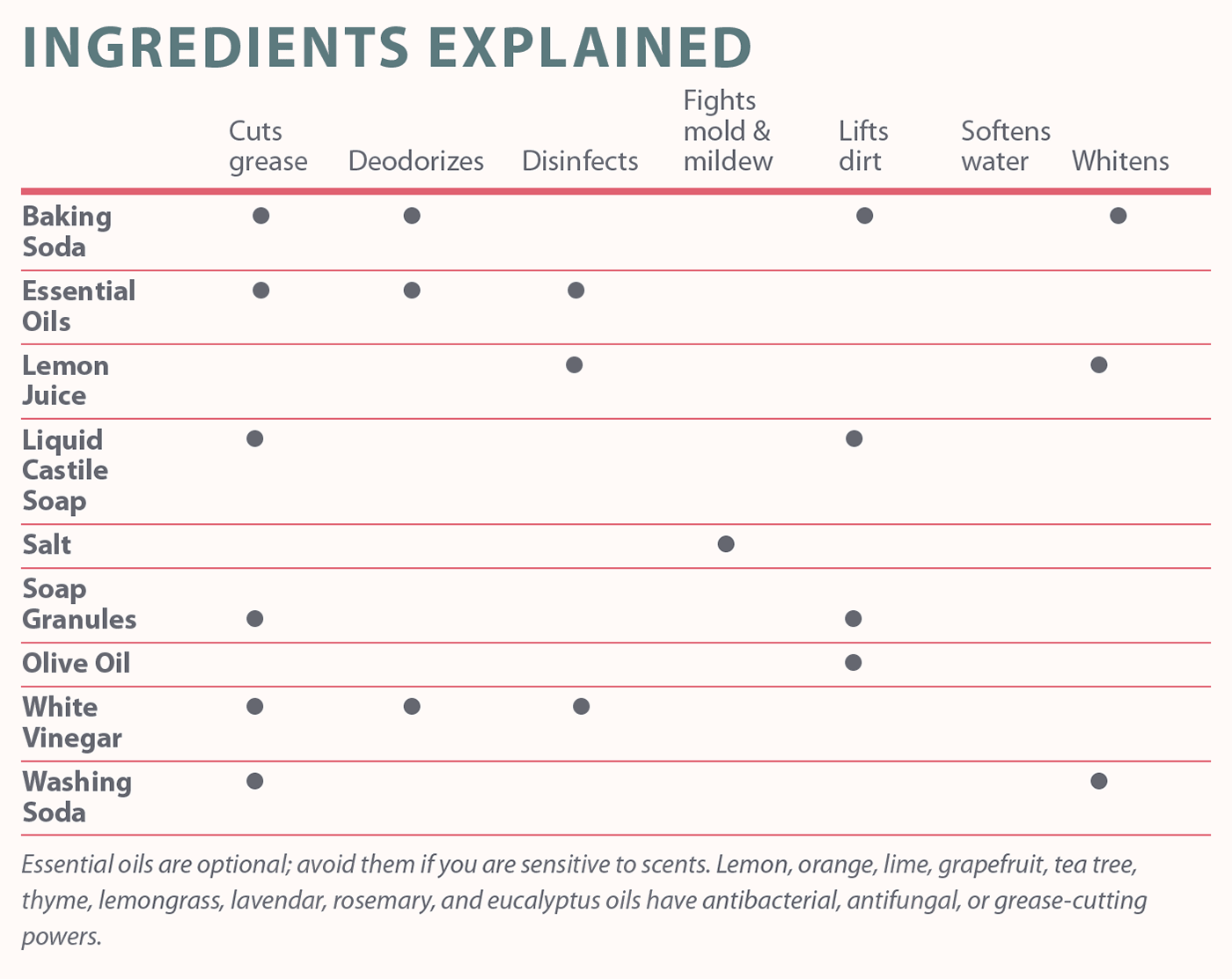
- See Recipes below or to the right.



